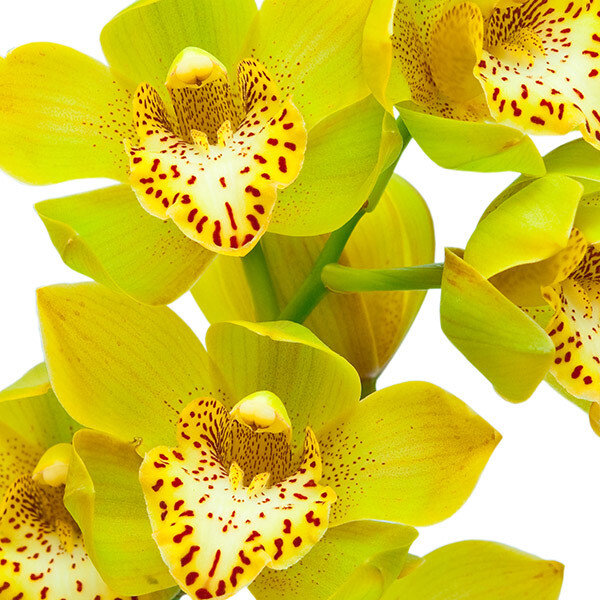
Also known as ‘boat orchids’ – Cymbidium Orchids are traditionally used for corsages and cut flower displays. They’re also a popular houseplant, and when taken care of correctly, they can flower for between eight and ten weeks.
The flowers are usually extremely large in size and appear patterned on the surface. Available in almost every hue but blue, they make the perfect addition to any space. They’re also one of the most maintenance-free orchids available to buy, making them an ideal option for those who possess busy working and social lives.
Cymbidium spikes bloom just once, which makes them a little different from other orchid species. This type of plant tends to flower in early spring, however they’re also known to bloom in October and sometimes up until late June! They’re also a little tougher than other orchid species and can thrive in cooler temperatures. This makes them a great option for those who reside in area with a milder climate. In certain cases, they can also be grown outside. When planting your orchid in the garden, it’s important to be wary of pests. If the orchid begins to show little or large holes and shredding, it’s likely it’s been attacked by garden predators.
If you follow care instructions from experienced growers down to the last detail, you’ll be able to keep your Cymbidium Orchid outside during the frost-free months.
Water Requirements
For best results, this particular plant should be watered in the morning, as this will allow plenty of time for the Orchid to dry prior to the coolness of night. It’s important to avoid soggy soil, and when watering your orchid, it’s advisable to use tepid water.
The frequency of watering an orchid can vary greatly, especially in the warm summer months, as the plant is likely to require more water. Most people will water their orchid once a week in the summer, and less frequently come the winter months.
Tips: Once the Orchid’s pseudobulbs have grown to their maximum growth (this should occur in the late summer), you can reduce the amount of water you give your plant. It is however imperative that you avoid the soil drying out completely.
Light Requirements
Orchid’s, particularly Cymbidiums, require medium to bright light in order to flourish. If the plant’s leaves look a yellow-green colour, it has enough sunlight. If the leaves are overly yellow, this is the sign the Orchid has too much light. If they’re extremely dark green, then it’s likely it doesn’t have enough light.
If you have an east-facing windowsill available in your home or office, this is the perfect place to position your orchid. A slightly shaded south-facing window is a good alternative. If you wish to put your orchid in the garden, choose an area that is sheltered from direct sunlight.
Fertiliser Options
When your Cymbidium Orchid is in active growth, it’s recommended you fertilise the plant on a regular basis using a solution of 20-20-20. In the winter months, spraying the plant with fertiliser just once a month is adequate. The only time you should avoid adding fertiliser to the orchid is if it’s extremely dry, as the strong chemicals can cause a great deal of damage to the plant.
Temperature Requirements
The perfect day temperature for orchids during the summer months is between 23.9°C and 29.4°C. At night, this can lower to between 10°C and 15.6°C. Having a temperature difference of 20 degrees will help to initiate the growth of flower spikes. In the winter, day temperatures can be between 18.3°C and 29.9°C, whilst recommended night temperatures are between 7.2°C and 12.8°C.
Humidity Requirements
In the colder months, Cymbidium orchids require humidity levels of 40-60%. During the winter, the orchid is generally in bud. If you live in a colder climate, you can use a humidifier or a humidity tray to help increase these levels. If you live in an extremely warm climate, try to encourage air movement as too much heat can breed disease.
Potting Requirements
It’s important to pot this type of orchid every two years (or when the existing pot has ceased from draining properly). The best pot to use is a clay pot; as such a material is able to encourage water evaporation. The best time to re-pot an orchid is the spring, once the flowers have bloomed. Prior to transferring the plant to a new pot, cut away any marred roots using a sterile cutting tool.
If you wish to divide your existing orchids and plant each bulb in a different pot, it’s wise to do so only when the orchid is showing new growth. Each plant must have between three and five pseudobulbs if you wish to divide them.
Another way to breed your orchids is to use the backbulbs. These have no leaves and are the oldest part of the plant. To remove them, simply use a sterile cutting tool. You should also remove any dead or discoloured leaves and re-pot the selected bulbs in separate small containers. Choose an area that is a little on the shady side and ensure the backbulbs are kept moist. It will only take a matter of months before you begin to see new growth. It will take around three years to achieve a full-sized plant.
If you’re unsure of when to re-pot your orchid, simply use your common sense. Although this specie doesn’t mind being planted alongside a number of the same specie, if shoots are starting to hang over the edge of the pot, or in the worst case scenario, it splits, then it’s time to move your plant to a bigger pot. Transferring your plant to a bigger home should usually take place around every two years.